Haocheng Xu
TOP: Time Optimization Policy for Stable and Accurate Standing Manipulation with Humanoid Robots
Aug 01, 2025Abstract:Humanoid robots have the potential capability to perform a diverse range of manipulation tasks, but this is based on a robust and precise standing controller. Existing methods are either ill-suited to precisely control high-dimensional upper-body joints, or difficult to ensure both robustness and accuracy, especially when upper-body motions are fast. This paper proposes a novel time optimization policy (TOP), to train a standing manipulation control model that ensures balance, precision, and time efficiency simultaneously, with the idea of adjusting the time trajectory of upper-body motions but not only strengthening the disturbance resistance of the lower-body. Our approach consists of three parts. Firstly, we utilize motion prior to represent upper-body motions to enhance the coordination ability between the upper and lower-body by training a variational autoencoder (VAE). Then we decouple the whole-body control into an upper-body PD controller for precision and a lower-body RL controller to enhance robust stability. Finally, we train TOP method in conjunction with the decoupled controller and VAE to reduce the balance burden resulting from fast upper-body motions that would destabilize the robot and exceed the capabilities of the lower-body RL policy. The effectiveness of the proposed approach is evaluated via both simulation and real world experiments, which demonstrate the superiority on standing manipulation tasks stably and accurately. The project page can be found at https://anonymous.4open.science/w/top-258F/.
Characterizing State Space Model (SSM) and SSM-Transformer Hybrid Language Model Performance with Long Context Length
Jul 16, 2025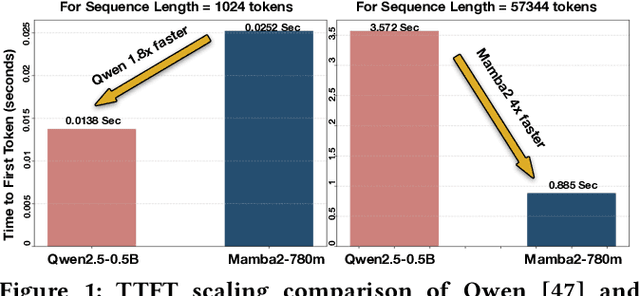
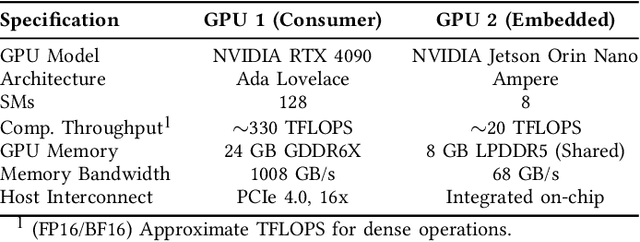
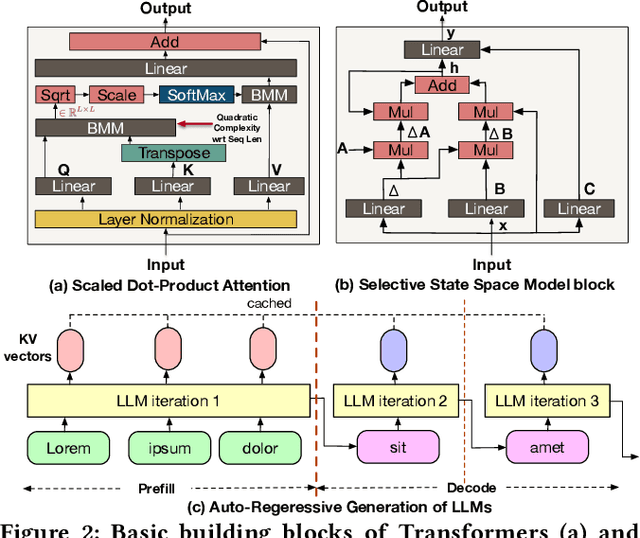
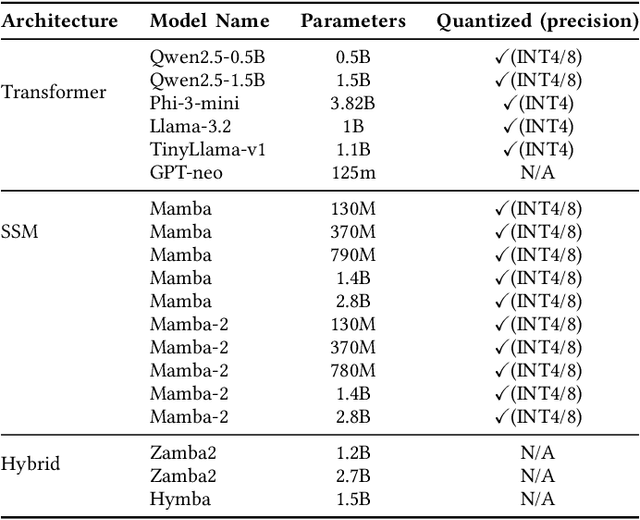
Abstract:The demand for machine intelligence capable of processing continuous, long-context inputs on local devices is growing rapidly. However, the quadratic complexity and memory requirements of traditional Transformer architectures make them inefficient and often unusable for these tasks. This has spurred a paradigm shift towards new architectures like State Space Models (SSMs) and hybrids, which promise near-linear scaling. While most current research focuses on the accuracy and theoretical throughput of these models, a systematic performance characterization on practical consumer hardware is critically needed to guide system-level optimization and unlock new applications. To address this gap, we present a comprehensive, comparative benchmarking of carefully selected Transformer, SSM, and hybrid models specifically for long-context inference on consumer and embedded GPUs. Our analysis reveals that SSMs are not only viable but superior for this domain, capable of processing sequences up to 220K tokens on a 24GB consumer GPU-approximately 4x longer than comparable Transformers. While Transformers may be up to 1.8x faster at short sequences, SSMs demonstrate a dramatic performance inversion, becoming up to 4x faster at very long contexts (~57K tokens). Our operator-level analysis reveals that custom, hardware-aware SSM kernels dominate the inference runtime, accounting for over 55% of latency on edge platforms, identifying them as a primary target for future hardware acceleration. We also provide detailed, device-specific characterization results to guide system co-design for the edge. To foster further research, we will open-source our characterization framework.
MONAS: Efficient Zero-Shot Neural Architecture Search for MCUs
Aug 26, 2024



Abstract:Neural Architecture Search (NAS) has proven effective in discovering new Convolutional Neural Network (CNN) architectures, particularly for scenarios with well-defined accuracy optimization goals. However, previous approaches often involve time-consuming training on super networks or intensive architecture sampling and evaluations. Although various zero-cost proxies correlated with CNN model accuracy have been proposed for efficient architecture search without training, their lack of hardware consideration makes it challenging to target highly resource-constrained edge devices such as microcontroller units (MCUs). To address these challenges, we introduce MONAS, a novel hardware-aware zero-shot NAS framework specifically designed for MCUs in edge computing. MONAS incorporates hardware optimality considerations into the search process through our proposed MCU hardware latency estimation model. By combining this with specialized performance indicators (proxies), MONAS identifies optimal neural architectures without incurring heavy training and evaluation costs, optimizing for both hardware latency and accuracy under resource constraints. MONAS achieves up to a 1104x improvement in search efficiency over previous work targeting MCUs and can discover CNN models with over 3.23x faster inference on MCUs while maintaining similar accuracy compared to more general NAS approaches.
RSEND: Retinex-based Squeeze and Excitation Network with Dark Region Detection for Efficient Low Light Image Enhancement
Jun 14, 2024
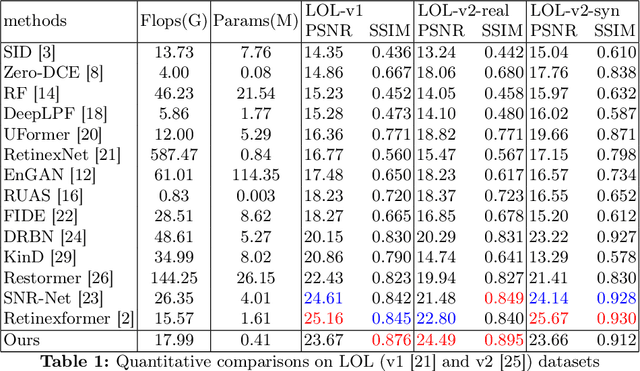
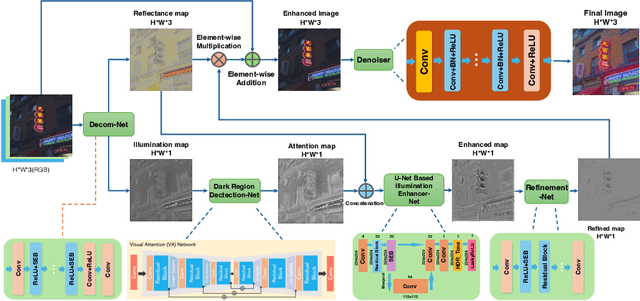
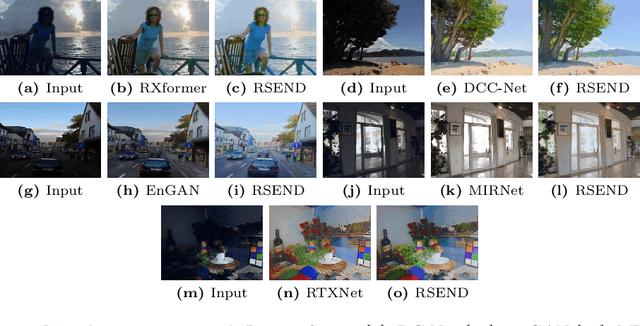
Abstract:Images captured under low-light scenarios often suffer from low quality. Previous CNN-based deep learning methods often involve using Retinex theory. Nevertheless, most of them cannot perform well in more complicated datasets like LOL-v2 while consuming too much computational resources. Besides, some of these methods require sophisticated training at different stages, making the procedure even more time-consuming and tedious. In this paper, we propose a more accurate, concise, and one-stage Retinex theory based framework, RSEND. RSEND first divides the low-light image into the illumination map and reflectance map, then captures the important details in the illumination map and performs light enhancement. After this step, it refines the enhanced gray-scale image and does element-wise matrix multiplication with the reflectance map. By denoising the output it has from the previous step, it obtains the final result. In all the steps, RSEND utilizes Squeeze and Excitation network to better capture the details. Comprehensive quantitative and qualitative experiments show that our Efficient Retinex model significantly outperforms other CNN-based models, achieving a PSNR improvement ranging from 0.44 dB to 4.2 dB in different datasets and even outperforms transformer-based models in the LOL-v2-real dataset.
TG-NAS: Leveraging Zero-Cost Proxies with Transformer and Graph Convolution Networks for Efficient Neural Architecture Search
Mar 30, 2024Abstract:Neural architecture search (NAS) is an effective method for discovering new convolutional neural network (CNN) architectures. However, existing approaches often require time-consuming training or intensive sampling and evaluations. Zero-shot NAS aims to create training-free proxies for architecture performance prediction. However, existing proxies have suboptimal performance, and are often outperformed by simple metrics such as model parameter counts or the number of floating-point operations. Besides, existing model-based proxies cannot be generalized to new search spaces with unseen new types of operators without golden accuracy truth. A universally optimal proxy remains elusive. We introduce TG-NAS, a novel model-based universal proxy that leverages a transformer-based operator embedding generator and a graph convolution network (GCN) to predict architecture performance. This approach guides neural architecture search across any given search space without the need of retraining. Distinct from other model-based predictor subroutines, TG-NAS itself acts as a zero-cost (ZC) proxy, guiding architecture search with advantages in terms of data independence, cost-effectiveness, and consistency across diverse search spaces. Our experiments showcase its advantages over existing proxies across various NAS benchmarks, suggesting its potential as a foundational element for efficient architecture search. TG-NAS achieves up to 300X improvements in search efficiency compared to previous SOTA ZC proxy methods. Notably, it discovers competitive models with 93.75% CIFAR-10 accuracy on the NAS-Bench-201 space and 74.5% ImageNet top-1 accuracy on the DARTS space.
MicroNAS: Zero-Shot Neural Architecture Search for MCUs
Jan 17, 2024Abstract:Neural Architecture Search (NAS) effectively discovers new Convolutional Neural Network (CNN) architectures, particularly for accuracy optimization. However, prior approaches often require resource-intensive training on super networks or extensive architecture evaluations, limiting practical applications. To address these challenges, we propose MicroNAS, a hardware-aware zero-shot NAS framework designed for microcontroller units (MCUs) in edge computing. MicroNAS considers target hardware optimality during the search, utilizing specialized performance indicators to identify optimal neural architectures without high computational costs. Compared to previous works, MicroNAS achieves up to 1104x improvement in search efficiency and discovers models with over 3.23x faster MCU inference while maintaining similar accuracy
Semantics-aware Motion Retargeting with Vision-Language Models
Dec 04, 2023



Abstract:Capturing and preserving motion semantics is essential to motion retargeting between animation characters. However, most of the previous works neglect the semantic information or rely on human-designed joint-level representations. Here, we present a novel Semantics-aware Motion reTargeting (SMT) method with the advantage of vision-language models to extract and maintain meaningful motion semantics. We utilize a differentiable module to render 3D motions. Then the high-level motion semantics are incorporated into the motion retargeting process by feeding the vision-language model with the rendered images and aligning the extracted semantic embeddings. To ensure the preservation of fine-grained motion details and high-level semantics, we adopt a two-stage pipeline consisting of skeleton-aware pre-training and fine-tuning with semantics and geometry constraints. Experimental results show the effectiveness of the proposed method in producing high-quality motion retargeting results while accurately preserving motion semantics. Project page can be found at https://sites.google.com/view/smtnet.
 Add to Chrome
Add to Chrome Add to Firefox
Add to Firefox Add to Edge
Add to Edge